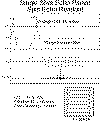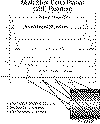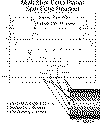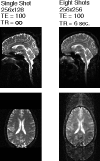Expansion:
Echo Planar Imaging
Multi-Shot Echo Planar Imaging
"blipped" Echo Planar Imaging
Technique:
Instead of acquiring spin echoes by using consecutive 180 degree refocussing pulses (as in FSE imaging), the sign of the readout (frequency-encoding) gradient is rapidly alternated and gradient echoes are acquired, resulting in markedly reduced scan times. MS-EPI requires several excitaions to cover the 64 to 128 views of k-space, while "single shot" EPI does this with one excitation, but requires faster and stronger gradients. Spin-echo EPI images can also be acquired, by rapidly switching gradients in a similar manner, this time following the 180 degree refocussing pulse.
Typical Paramaters:
MS-EPI: # of shots required is k-space views desired / ETL
GRE readout: ETL 4, TE (effective) 5 ms, echo spacing 5 ms
SE readout: ETL 4, TE (effective) 80 ms, echo spacing 5 ms
Reference:
All You Really Need to Know About MRI Physics, 8-10
Contributor:
Related Sequences/Terms:
GRE, SE, FE, GE, ETL
Comments:
| MS-EPI can be performed on many currently available MRI systems, while single-shot EPI requires expensive (rapidly switchable and strong) gradients |
| overall resolution and SNR lower than SE/FSE techniques |
| single-shot EPI is more sensitive to artifacts and field inhomogeneities than MS-EPI, which are more sensitive to motion |
Pulse Sequence Diagrams:
 Single Shot EPI Pulse Sequence Diagram
Single Shot EPI Pulse Sequence Diagram
 Multi -Shot EPI Sequence with GRE readout
Multi -Shot EPI Sequence with GRE readout

